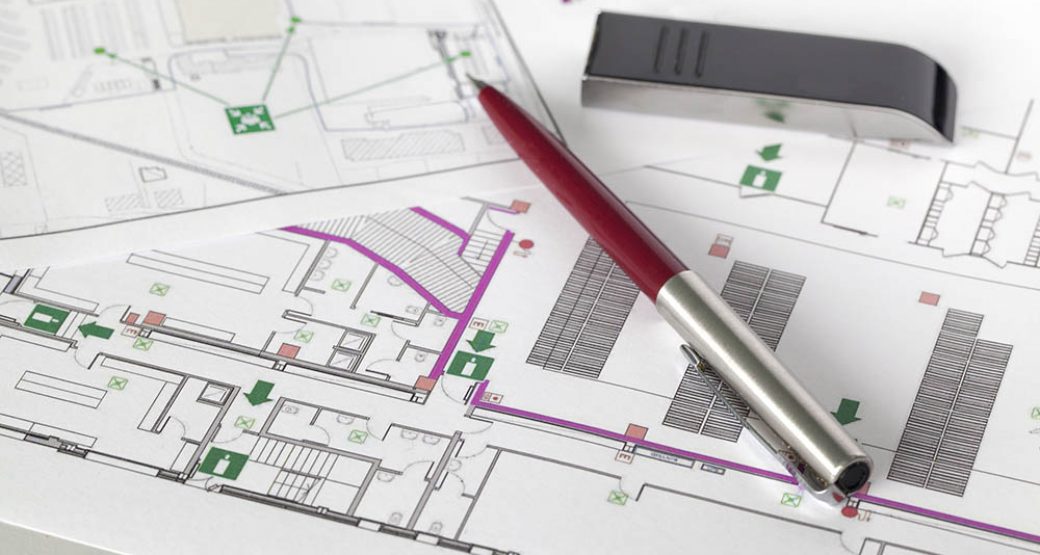Disaster can strike at any time, even if you do everything you can to keep your home or business safe. Under normal circumstances, a fire escape plan may seem obvious. You have smoke detectors right? If there’s a fire, you know and everyone will file out the front door. If you can’t go that way, you’ll go out the back or side doors. Simple, right?
But, fear and confusion can create havoc when there’s no clear plan in place, especially during a life-threatening emergency. Thick smoke can prevent you and your employees from easily making your way outside. At home, it may be unclear if elderly family members, children, or pets have been able to safely find a way out.
When it comes to disasters, preparedness is key. A good security system will go a long way in preventing disaster. But you still need to learn how to make an evacuation plan and have your family or staff practice it and commit it to memory.
Here’s how to make a fire escape plan.
Keys to Any Fire Escape Plan
Simply installing fire detectors isn’t enough to be fully prepared. If a fire breaks out at your home or at work, everyone in the structure needs to know the fire escape plan to get to safety. This is the final element of all fire and evacuation systems, and it’s important that everyone be on the same page in terms of the plan.
A proper fire escape plan involves drawing a floor plan of the home or office space, marking two different ways out of each room (utilizing both windows and doors). On a daily basis, it’s important that all occupants keep the planned escape routes clear of all obstructions, as well as ensure that all doors and windows can easily be opened.
Both at home and at work, a fire escape plan should include an outside place where everyone knows to meet. This will help to ensure that everyone is out of the structure and accounted for. Everyone should have the phone number of the fire department memorized in order to call for help (although fire and evacuation systems will notify rescue personnel when smoke, heat, or carbon monoxide are detected). Practice this plan twice a year to keep everyone up to speed — from new employees to younger children.
If a fire or carbon monoxide incident occurs, the consequences could be disastrous — but they don’t have to be. With the proper planning and installation of fire and evacuation systems, you’ll be making your residential and office space safe and ensuring that they’re monitored by professional teams and the latest technology.
Fire Escape at Home
First, make sure your house number is clearly visible from the road. This is critical to rescue personnel who may need to find your house in the event of an emergency. Next, assign responsibilities and identify who will be responsible for what. The first consideration, of course, is saving human lives and getting everyone out safely. Discuss who will be responsible for assisting young or elderly family members during the evacuation. Determine who will call for help once everyone is outside.
Only after you’re certain that everyone is safe should you worry about possessions. Never put yourself or anyone in danger to retrieve belongings. Consider keeping important documents in a plastic container or small box that can easily be located and taken with you in the event of an evacuation.
Again, agree on a safe meeting point. Perhaps this will be in a storm cellar, on the sidewalk a safe distance away from your home, or at the home of a family member who lives down the street. This will help ensure that everyone is accounted for as they exit the house. If the danger is inside the house, once everyone is out, make sure they stay out. Detailed evacuation plans are especially important for kids. Discuss how it’s important not to hide if ever there is a fire. Walk them through important fire safety tips such as how doorknobs can be hot if there is a fire on the other side and how shutting a door can prevent the spread of smoke. If their bedroom is on the first floor, have them practice opening the window in order to climb out. If it’s on the second floor, practice setting up an escape ladder, but don’t have them actually climb out during a drill. Make sure they know the sound your security system’s siren will make when there is a fire vs. a burglary. Remember, you can put your system on test and let your kids hear the difference without worrying about accidentally notifying the first responders.
Finally, hold practice drills for the entire family. Go through each step of the evacuation, from the discovery of the emergency to everyone arriving at your meet-up point. This is especially important for kids. In addition to practicing the evacuation, have them memorize their address, 911, and any emergency phone numbers that would be appropriate. Even for adults, remember that practice makes perfect. It’s not enough to simply know what you would do in the event of an emergency. When fear and adrenaline kick in, you need to be able to walk through the evacuation steps without stopping to think about it. This is why making an evacuation plan well in advance simply makes sense.
Fire Escape at Work
In the midst of an emergency, anxiety and noise can create chaos. Educating employees about your office emergency evacuation plan before an unexpected event strikes is the best way to prevent injuries and loss of life. Make sure that your employees are aware of what certain alarms sound like so they will know how to react.
Carrying out drills will help familiarize them with what to expect from your fire and evacuation system. The system will feature visual, as well as audible alerts in order to notify those who can not hear the sound of an alarm during an emergency. Establish a clear chain of command to prevent confusion during the evacuation. Designate individuals who are authorized to make key decisions around authorizing a shutdown or evacuation of the premises. These should be level-headed individuals who are capable of directing and calming everyone as they assist them through the evacuation.
Ensure that you have procedures in place to assist people who are elderly, disabled, or who do not speak English. Decide if any employees will be needed to continue or shut down operations in the midst of an emergency. Also designate individuals who will be responsible for shutting off electricity, gas, or water to the building if ordered to do so by emergency officials. Develop a system to ensure that all areas are clear and that everyone has been safely evacuated. This should include a way to account for all employees after the evacuation.
The most essential element to an office emergency evacuation plan is preparedness. Ensure that your building follows proper guidelines for having safe evacuation routes. This means having them well-lit and clearly marked. Ensure that hallways are wide enough to accommodate all evacuees and that they always remain unobstructed. Train employees on ways to prevent fires and avoidable accidents and hazards. In addition to this, install a fire and safety system that will constantly monitor the environment for threats and provide alerts and guidance should one arise. You never know when an emergency will arise, but when one occurs, a well-designed security system is the best way to help mitigate the threat and save lives.
At ProTech Security, we have a strong history of experience, innovation, and customer service. The ProTech Security Advantage is more than 35 years of service in Northeast Ohio and a strong commitment to providing quality, cost-effective protection for homes, businesses, educational institutions, and government facilities. To see what ProTech Security can do for you, contact us today.



